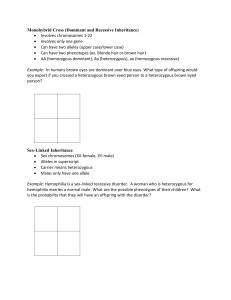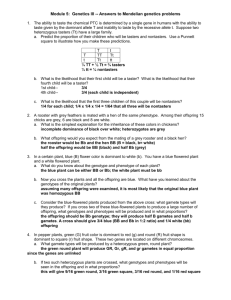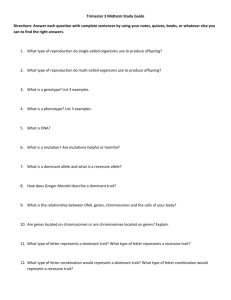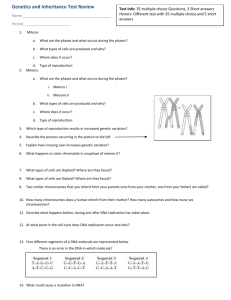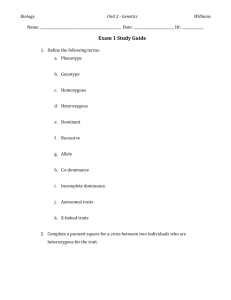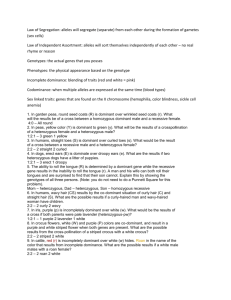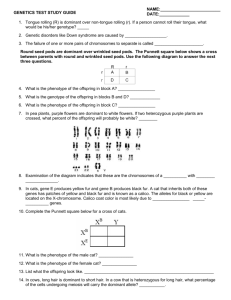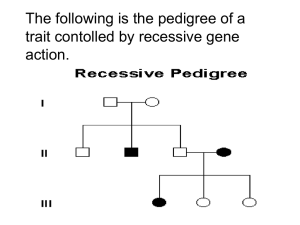Topic 4.3: Theoretical Genetics Practice Problems Answer the
advertisement
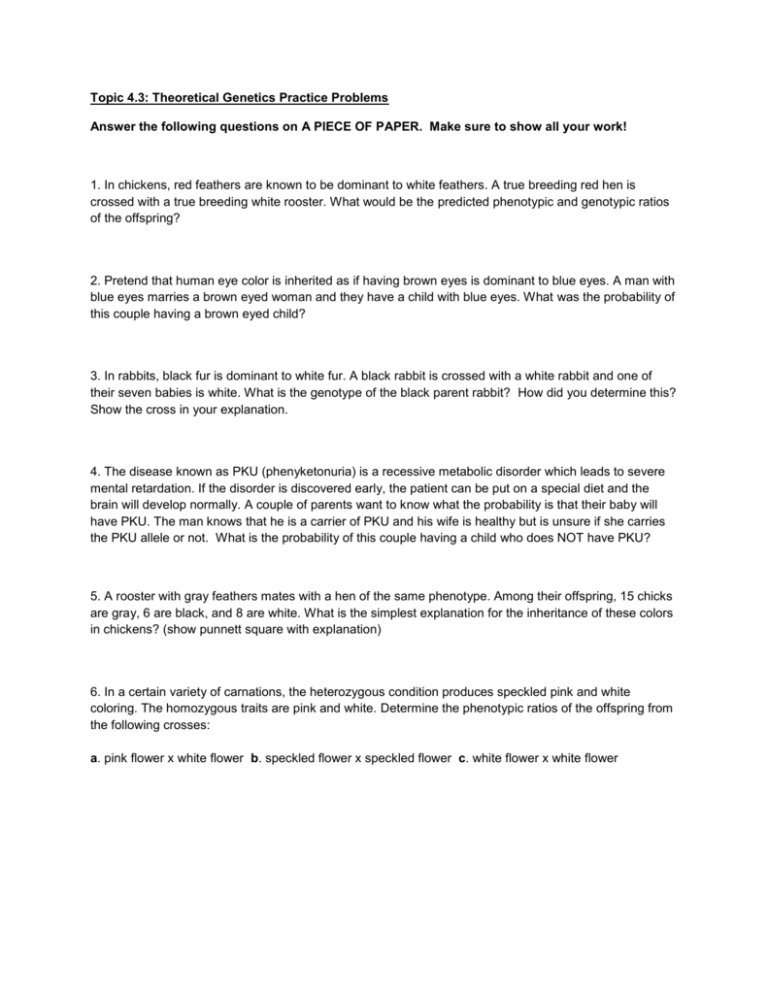
Topic 4.3: Theoretical Genetics Practice Problems Answer the following questions on A PIECE OF PAPER. Make sure to show all your work! 1. In chickens, red feathers are known to be dominant to white feathers. A true breeding red hen is crossed with a true breeding white rooster. What would be the predicted phenotypic and genotypic ratios of the offspring? 2. Pretend that human eye color is inherited as if having brown eyes is dominant to blue eyes. A man with blue eyes marries a brown eyed woman and they have a child with blue eyes. What was the probability of this couple having a brown eyed child? 3. In rabbits, black fur is dominant to white fur. A black rabbit is crossed with a white rabbit and one of their seven babies is white. What is the genotype of the black parent rabbit? How did you determine this? Show the cross in your explanation. 4. The disease known as PKU (phenyketonuria) is a recessive metabolic disorder which leads to severe mental retardation. If the disorder is discovered early, the patient can be put on a special diet and the brain will develop normally. A couple of parents want to know what the probability is that their baby will have PKU. The man knows that he is a carrier of PKU and his wife is healthy but is unsure if she carries the PKU allele or not. What is the probability of this couple having a child who does NOT have PKU? 5. A rooster with gray feathers mates with a hen of the same phenotype. Among their offspring, 15 chicks are gray, 6 are black, and 8 are white. What is the simplest explanation for the inheritance of these colors in chickens? (show punnett square with explanation) 6. In a certain variety of carnations, the heterozygous condition produces speckled pink and white coloring. The homozygous traits are pink and white. Determine the phenotypic ratios of the offspring from the following crosses: a. pink flower x white flower b. speckled flower x speckled flower c. white flower x white flower 7. Maria has type O blood and her sister has type AB blood. What are the genotypes of their parents? What other genotypes (and in what frequencies) would you expect in other children from these parents? 8. A woman with type A blood and a man with type B blood could possibly have children with what phenotypes? There are 4 possible crosses between these parents, show all of them! 9. In cattle coat color RR is red, WW is white and RW is roan (both red and white hairs). What type of inheritance is this? A rancher has a roan bull and white cows but wants a herd of all red cattle. Outline a breeding program to produce all red cattle. Use Punnett squares to support your explanation. 10. In fruit flies, eye color is sex-linked. Red eyes are dominant to white eyes. A female fruit fly of unknown genotype was crossed with a white-eyed male. Roughly half of the male offspring and half of the female offspring were white-eyed. What was the genotype of the female? Show your work. 11. A human female "carrier" who is heterozygous for the recessive, sex-linked trait causing red-green color blindness marries a normal male. What is the probability of having a child who is colorblind? Show your work. 12. Hemophilia (a blood clotting disorder) in humans is due to an X-Chromosome mutation. What will the results of a mating between a normal (non-carrier) female and a hemophiliac male? Show your work. 13. Although Beatrice is an accomplished painter with normal vision, her dad is colorblind. What are the odds that she might pass on the gene for colorblindness to her offspring? Explain. 14. Women have sex chromosomes XX and men have sex chromosomes XY. Which of a woman's grandparents could NOT be the source of any of the genes on either of her X-chromosomes? Draw a diagram (pedigree) that helps your solve this and use it to explain your answers. 15. A pea plant is heterozygous for both seed shape and seed color. Yellow is dominant to green and wrinkled is dominant to smooth. Give the genotype and phenotype ratios of the offspring that you would expect from two plants that are heterozygous for both characteristics. 16. Create a pedigree for the following description and answer the question at the end. A man and woman marry. They have five children, 2 girls and 3 boys. The mother is a carrier of hemophilia, an X-linked disorder. She passes the gene on to two of the boys who died in childhood and one of the daughters is also a carrier. Both daughters marry men without hemophilia and have 3 children (2 boys and a girl). The carrier daughter has one son with hemophilia. One of the non-carrier daughter’s sons marries a woman who is a carrier and they have twin daughters. What is the percent chance that each daughter will also be a carrier? 17. Pedigree Problem: Below is a pedigree for an inherited heart disease. What is the probability that their child F would have the inherited heart disease? What type of inheritance would you consider this heart disease to be? (Xlinked recessive, autosomal recessive, autosomal dominant). How do you know?



